In the ever-evolving landscape of digital marketing, email remains a cornerstone of customer engagement and brand communication. As businesses seek to optimize their email marketing strategies, two platforms consistently emerge as frontrunners: AWeber and Mailchimp. Both offer robust features and user-friendly interfaces, but which one truly stands out in the competitive arena of email marketing software?
This comprehensive analysis delves deep into the strengths, weaknesses, and unique offerings of AWeber and Mailchimp. We’ll explore their key features, automation capabilities, user experience, and pricing models to help you make an informed decision for your business. Additionally, we’ll uncover five hidden gems strategies that can enhance your email marketing efforts, and introduce Prism Reach—an innovative AI-powered tool designed to take your email campaigns to the next level.
Key Facts
- AWeber offers over 700 email templates, significantly surpassing Mailchimp’s 100+ options.
- Mailchimp provides a more advanced Customer Journey builder for complex automation strategies.
- AWeber consistently scores higher in email deliverability tests compared to Mailchimp.
Battle of the Titans: AWeber and Mailchimp Face Off
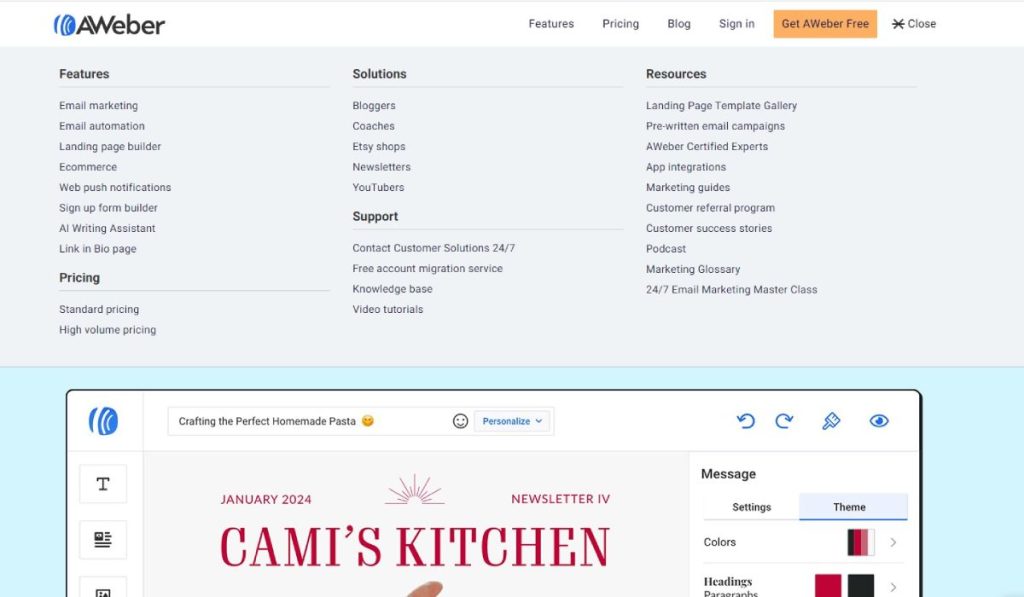
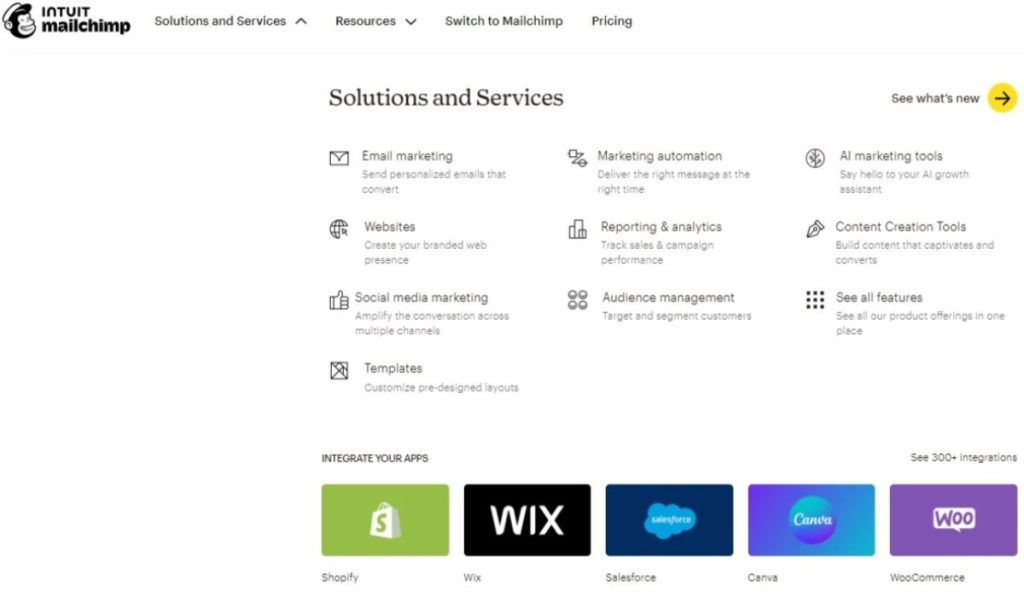
User Interface and Ease of Use
AWeber is renowned for its user-friendly interface and straightforward approach to email marketing. The platform’s clean design and intuitive navigation make it an excellent choice for beginners or those who prefer a no-frills approach to their email campaigns.
On the other hand, Mailchimp positions itself as a more comprehensive marketing platform. Its interface is slightly more complex, reflecting its broader range of features. This can be advantageous for businesses looking for an all-in-one solution but might present a steeper learning curve for newcomers.
Template Variety and Design Options
AWeber takes the lead in template variety, offering over 700 email templates. This extensive range provides users with ample design options to suit various industries and campaign types. As email marketing expert Tom Kulzer notes, “AWeber’s intuitive autoresponder setup allows even beginners to create sophisticated email sequences with minimal effort.”
Mailchimp, while offering fewer templates (over 100), compensates with highly customizable options and a drag-and-drop editor. This allows for greater flexibility in design, albeit with a smaller starting pool of templates.
Automation Capabilities
Both platforms offer automation features, but Mailchimp edges out with its advanced Customer Journey builder. This tool enables marketers to create complex, multi-step campaigns based on subscriber behavior and preferences. Mailchimp’s co-founder Ben Chestnut explains, “Our goal with the Customer Journey builder was to empower marketers to create highly personalized, behavior-driven campaigns that truly resonate with their audience.”
AWeber’s automation tools, while robust, are more straightforward. They excel in creating simple autoresponder sequences and basic behavioral triggers, making them ideal for businesses with less complex automation needs.
Deliverability Rates
Deliverability is crucial in email marketing, and AWeber holds a slight advantage in this area. Independent tests consistently show that AWeber’s emails are more likely to land in the primary inbox rather than promotional tabs or spam folders. This can be a significant factor for businesses where every opened email counts towards their bottom line.
Pricing Structures
AWeber’s pricing structure is more straightforward, with most advanced features available even on lower-tier plans. This can be advantageous for growing businesses that need access to more sophisticated tools without a significant price jump.
Mailchimp offers a more generous free plan, making it attractive for very small businesses or those just starting out. However, many of its advanced features are reserved for higher-priced tiers. This tiered approach can make Mailchimp more cost-effective initially but potentially more expensive as your subscriber list grows and your need for advanced features increases.
- Free Plans: Mailchimp offers a free plan for up to 2,000 contacts, while AWeber only offers a free trial.
- AWeber: Pricing based on the number of subscribers, with unlimited email sends on all plans.
- Mailchimp: Pricing based on both the number of contacts and email send volume.
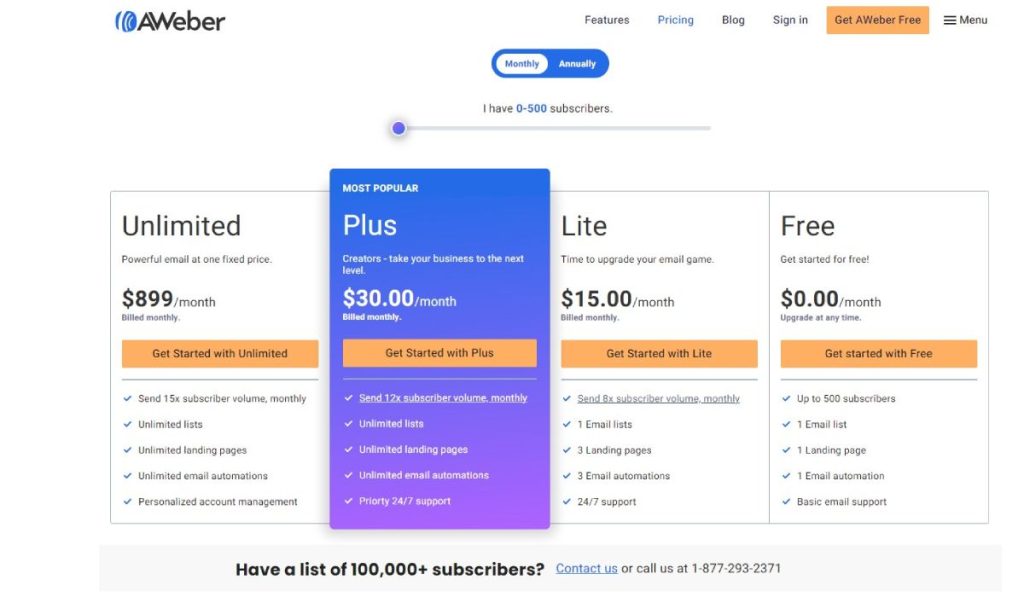

Analytics and Reporting
Both platforms offer robust analytics and reporting options, but Mailchimp takes the lead with its more detailed and customizable reports. This depth of data can be particularly beneficial for data-driven marketers who rely heavily on analytics to refine their strategies and improve campaign performance over time.
AWeber’s analytics, while comprehensive, are more straightforward. They provide clear, actionable insights without overwhelming users with excessive data points.
Integration Capabilities
Integration capabilities are strong for both platforms, but Mailchimp’s extensive list of over 220 integrations gives it a clear advantage. This wide range of connections is especially beneficial for businesses using a variety of other marketing and e-commerce tools, allowing for seamless data flow and campaign coordination across platforms.
AWeber, while offering fewer integrations, still connects with many popular platforms and services, covering the needs of most small to medium-sized businesses.
Hidden Gems: Lesser-Known Strategies to Boost Your Email Marketing
1. Leverage Web Push Notifications
AWeber offers web push notifications, a feature not available in Mailchimp. Use this to complement your email campaigns and reach subscribers even when they’re not checking their inbox. Web push notifications can help increase engagement by delivering timely updates directly to users’ browsers.
2. Exploit AWeber’s Custom Sales Pages
While Mailchimp focuses on email marketing, AWeber provides custom sales pages. Utilize this feature to create targeted landing pages that seamlessly integrate with your email campaigns. Custom sales pages can enhance conversion rates by providing a cohesive user experience from email to purchase.
3. Implement the Auto Resend Feature
Use AWeber’s Auto Resend feature to give subscribers a second chance to open important emails. This can significantly increase your open rates and engagement by targeting those who may have missed your initial email.
4. Utilize AWeber’s Domain-Based Click Tracking
AWeber’s click tracking uses your domain’s URL, which can lead to higher click-through rates compared to Mailchimp’s long, obscure links. Domain-based tracking not only enhances brand recognition but also builds trust with your audience.
5. Implement Audio and Video in Registration Forms
AWeber’s registration forms allow you to add audio and video elements. Use this unique feature to create more engaging and interactive sign-up experiences. Multimedia elements can capture attention and convey your brand message more effectively than text alone.
Innovative Solutions by Prism Reach
While AWeber and Mailchimp offer powerful email marketing solutions, the landscape is evolving rapidly with the advent of AI-driven personalization. This is where Prism Reach enters the picture, offering a revolutionary approach to email marketing that addresses some of the limitations of traditional platforms.
Company and Product Overview
Prism Reach is an innovative AI-powered SaaS solution designed to enhance the effectiveness of email marketing campaigns through deep personalization. This platform stands out by transforming how publishers and content creators engage with their audiences, using sophisticated AI algorithms to customize every aspect of newsletters based on subscriber behavior and preferences.

Key Features
- AI-Powered Personalization: Prism Reach utilizes AI to cluster content and create detailed user avatars, enabling highly personalized newsletter content.
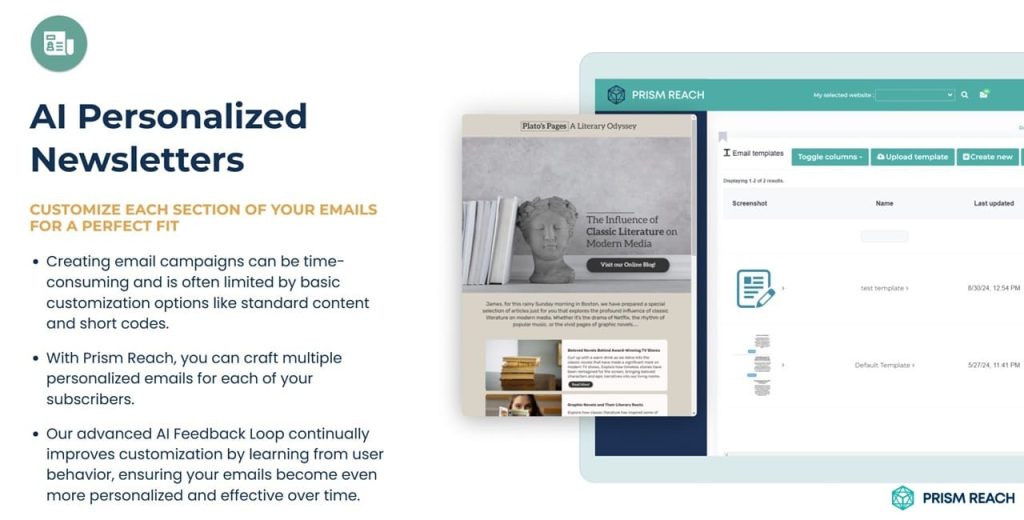
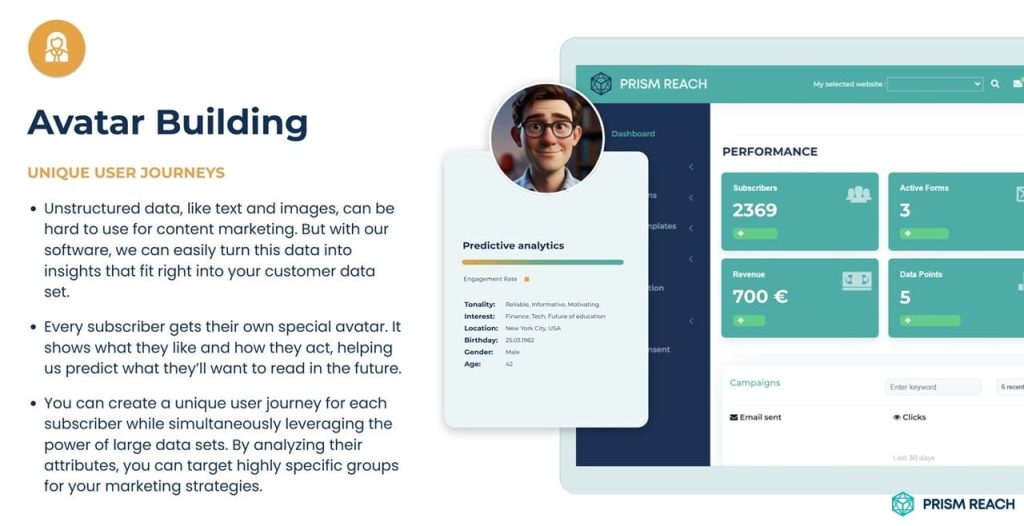
- Seamless Setup and Integration: The platform can be integrated within minutes, allowing for quick adoption and efficient migration of existing subscriber lists.
- Dynamic Content Selection: The AI determines the most relevant content for each subscriber, enhancing personalization and engagement.
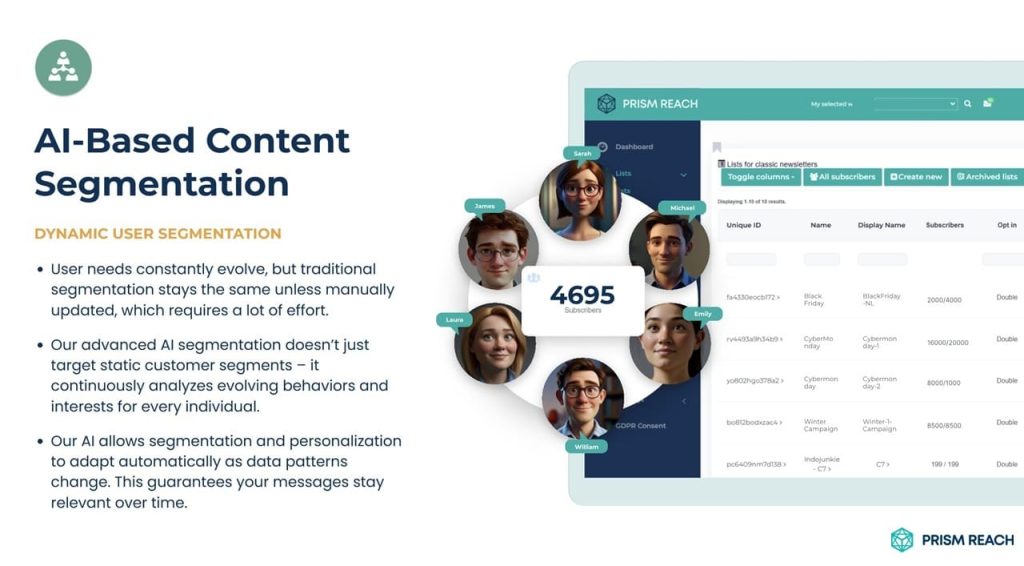
Benefits of Prism Reach
- Enhanced Subscriber Engagement: AI-driven personalization ensures that each subscriber receives content tailored to their interests, increasing engagement rates.
- Streamlined Email Marketing Processes: Seamless integration and easy setup save time, allowing marketers to focus on strategy rather than technical setup.
- Deep Audience Insights: Advanced analytics provide deeper understanding of subscriber behavior, enabling more informed marketing decisions.
Prism Reach vs. Traditional Platforms
Unlike traditional email marketing tools like AWeber and Mailchimp, Prism Reach leverages AI to offer a level of personalization that goes beyond basic segmentation. By creating detailed user avatars and analyzing vast amounts of data, Prism Reach delivers content that is not only relevant but also timely, enhancing the overall impact of your email marketing campaigns.
Seamless Integration with AWeber and Mailchimp
Prism Reach is designed to work alongside existing platforms like AWeber and Mailchimp, enhancing their capabilities with advanced AI features. Whether you’re looking to boost engagement, streamline your processes, or gain deeper insights, Prism Reach complements your current tools to maximize your email marketing success.
Upgrade Your Email Marketing with AI Personalization!
FAQ
Conclusion
Both AWeber and Mailchimp offer robust email marketing solutions, each with its own strengths. AWeber shines with its user-friendly interface, extensive template library, and superior deliverability rates. Mailchimp, on the other hand, offers a more comprehensive marketing platform with advanced automation and detailed analytics.
The choice between the two will largely depend on your specific business needs, technical expertise, and growth plans. For those prioritizing ease of use and straightforward email marketing, AWeber might be the better choice. For businesses looking for a more all-encompassing marketing platform with advanced features, Mailchimp could be the way to go.
However, as the email marketing landscape evolves, solutions like Prism Reach are pushing the boundaries of what’s possible with AI-driven personalization. For businesses looking to stay ahead of the curve and provide truly personalized content to their subscribers, exploring innovative platforms like Prism Reach could be a game-changing decision.
Upgrade your email marketing strategy today by leveraging the strengths of AWeber or Mailchimp, and consider integrating Prism Reach to unlock the full potential of AI-powered personalization.
Sources
- Barn Images. (n.d.). Tips for Email Marketing with Mailchimp and MailerLite. Retrieved from https://barnimages.com/blog/tips/email-marketing-mailchimp-mailerlite/
- Email Tool Tester. (n.d.). Mailchimp vs AWeber: Detailed Comparison. Retrieved from https://www.emailtooltester.com/en/blog/mailchimp-vs-aweber/
- Heather Jones. (n.d.). AWeber vs Mailchimp: Email Marketing Tools Faceoff for Affiliate Marketers. Retrieved from https://www.heatherjones.org/aweber-vs-mailchimp-email-marketing-tools-faceoff-for-affiliate-marketers/
- My Wife Quit Her Job. (n.d.). Mailchimp vs AWeber: A Comparison of Two Email Marketing Providers. Retrieved from https://mywifequitherjob.com/mailchimp-vs-aweber-a-comparison-of-two-email-marketing-providers/